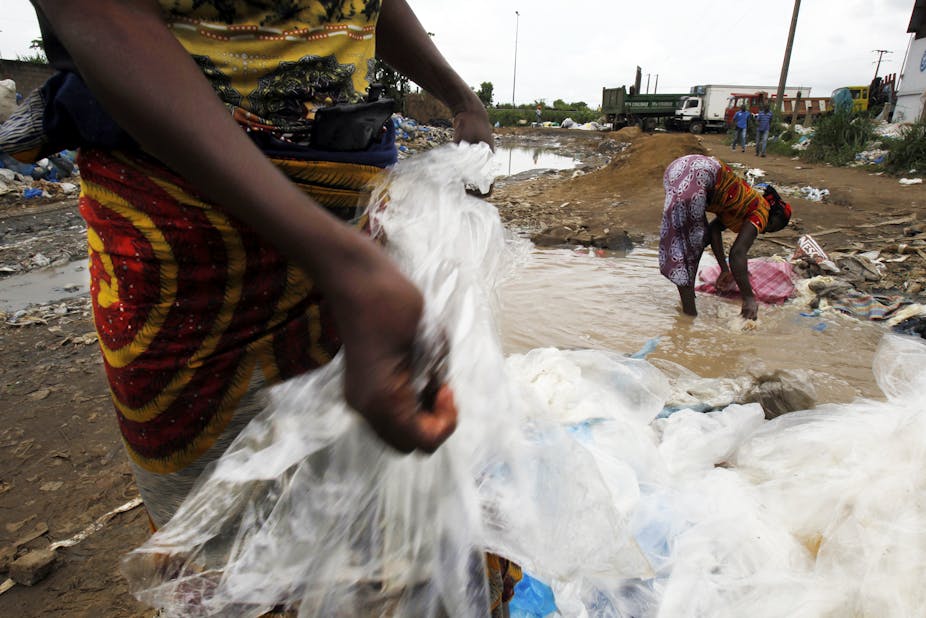Kenya recently announced a ban on one of the most common materials used in the country’s packaging sector - plastic bags. This includes the use, manufacture and importation of all plastic bags used for commercial and household packaging.
This isn’t the first time the East African nation has tried to do this and the directive comes about 10 years after the first attempt. That one failed, primarily because of a lack of consistent follow up on the agreed implementation plan.
My research on the management of plastic waste in urban Kenya shows that this new ban is not realistic. The policy direction is not based on the local context or any extensive research regarding implications of the ban. It doesn’t consider the impact that it will have economically or give due consideration to other environmental alternatives.
Kenya’s plastic bag industry
Plastic materials offer a number of advantages over other conventional packaging materials. They are malleable, light, low cost and can be produced in a variety of shapes and sizes. Because of this, every year over 260 million tons of plastics are produced globally. Of this, nearly one trillion plastic bags are made and used. This makes them an important feature of the packaging sector.
Plastic bag manufacturing forms a sizeable portion of the plastic manufacturing sector. It has a long history dating back to the 1930s. Today there are over 30 plastic bag manufacturers with a combined capital investment worth over USD$77.3million (Ksh5.8 billion). They employ up to 9,000 people, both directly and indirectly. Some 100 million plastic shopping bags are given out every month by supermarkets. This is a massive contribution to the plastics sector and to the country’s economy.
Plastic bags also have an extremely important role in the average person’s daily life as they stand out for their excellent fitness for use, resource efficiency and low price. For Kenya, where 56% of the population live on less than a dollar per day, plastic bags support the “kidogo” economy - synonymous with the majority. This economy is based on the small amounts people buy - for example one cup of cooking oil, or a handful of washing powder or squeeze of toothpaste. To take these home they need the small plastic bags.
Pollution
But because plastic bags are resistant to biodegradation, they cause long-term pollution to various natural environments from oceans to soil. Of the 4,000 tons of single use plastic bags produced each month, about 2,000 tons end up in Kenya’s municipal waste streams. Half of these are lightweight bags with a thickness of less than 15 microns.
Because of these issues, a variety of policy measures can be introduced to manage plastic waste. These include a ban on the production of certain plastics, levying taxes, mandatory recycling targets and adoption of anti-plastic bag campaigns.
Kenya has chosen the path of a ban on use, manufacture and importation of all plastic bags used for commercial and household packaging. But my research shows that plastic waste recovery and recycling is a better strategy for sustainable plastic waste management. This is particularly true for developing economies because employment opportunities can be created within the recycling chain.
One option that won’t work is substituting plastic bags with biodegradable ones. First, the tear strength of biodegradable packaging bags is low compared to their petrochemical counter parts. They also have a high rate of water absorption. Most developing countries are also not equipped with the technological capacity to produce biodegradable material. Lastly, they are still not cost effective. The cost of most bio plastic polymers fall in the range of USD$2-5 per kg, compared to approximately USD$1.3 per kg for the usual petrochemical polymers. These factors make biodegradables a poor substitution.
Which is why the solution lies with plastic recovery and recycling.
Recovery and recycling
The reuse and recycling of plastic waste makes much more sense – particularly since Kenya doesn’t have a petrochemical industry needed to make plastic. Raw materials for the plastics and polythene industries are imported from overseas.
Plastic waste recycling is not a recent phenomenon in Kenya - it dates back to the 1960s. A 2001 survey showed that over 90% of Kenya’s plastic manufacturing industries have internal reprocessing capacity for their own waste and rejects.
Trading in plastic waste has been practised in Kenya since the 1980s. Waste pickers and small-scale traders started to sell unprocessed plastic waste directly to plastic producers for use as a raw material in the manufacture of new plastic products.
This plastic waste collection, by informal actors, presents a more realistic and sustainable solution to plastic waste management in Kenya. The waste becomes a source of raw material for the production of plastic materials, creating an interdependent relationship between solid waste management systems and plastic production.
Kenya needs to create an integrated plastic waste management system. It already has three well established categories of plastic waste recycling industries. These need to be properly linked to plastic waste collection and separation chains.
It would need the support and coordination from government, industry and civil society at all levels. Including:
Separating plastic waste from other waste streams and the further separation of various plastic materials for effective use of different polymer wastes in production.
The protection of waste pickers and those who add value including washing and sorting to plastic waste
The allocation of space for waste separation centres
Technological and financial support for waste processing
Education outreach programs
Plastic product marketing to popularise the diverse products
Introducing deposit and return systems in supermarkets
Improved transport logistics or plastic products and plastic waste so that such can reach their destinations in time.
Kenya would be better off pursuing waste management strategies. These include waste separation and the development of rules that require plastic industries to take back certain quantities of plastic waste from the solid waste management system to enhance recycling.

